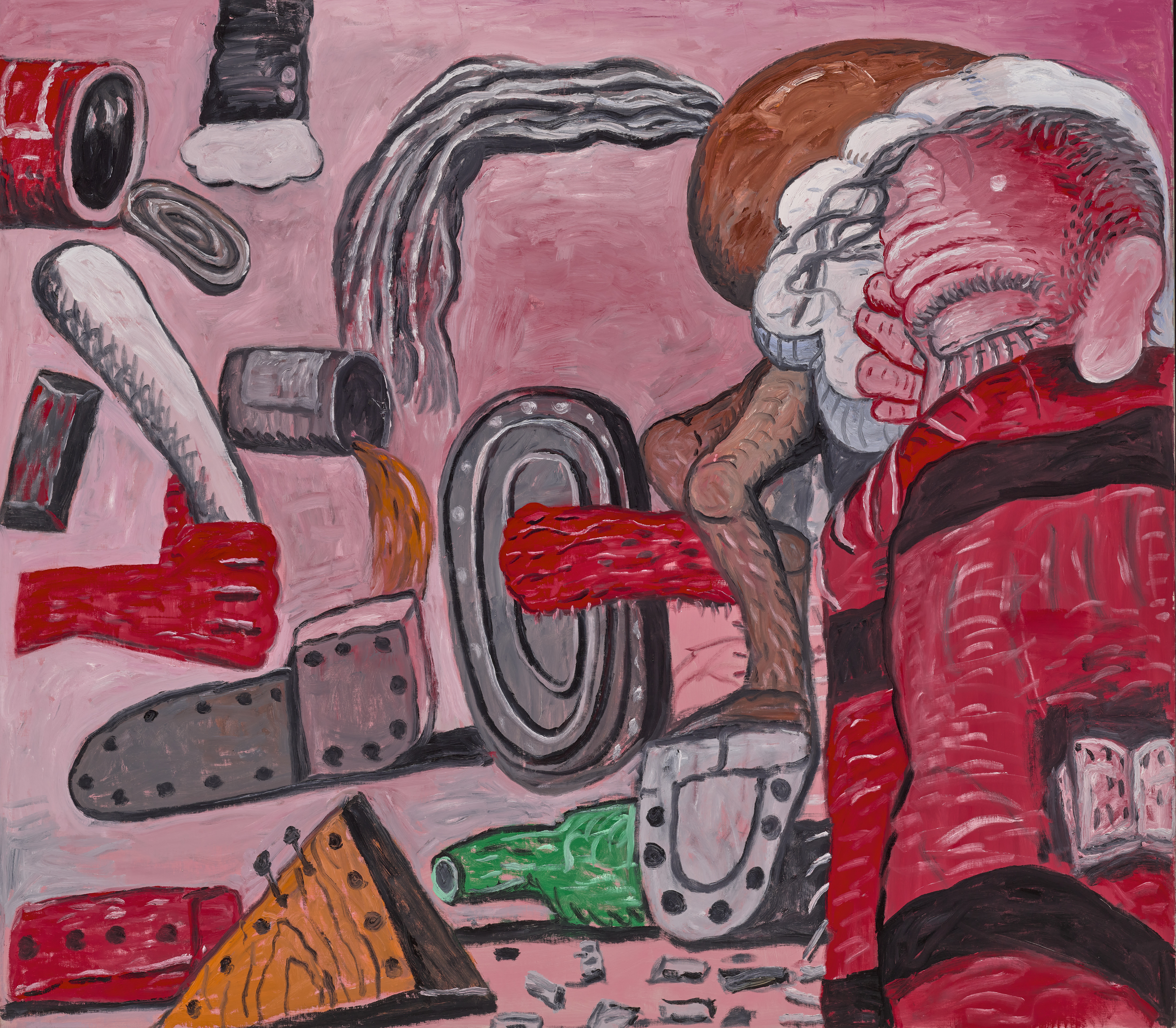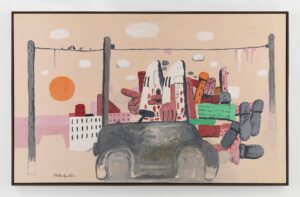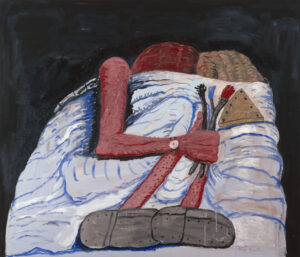The Studio by Philip Guston (1969). © The Estate of Philip Guston, courtesy Hauser & Wirth.
Two years late and trailing clouds of derision after the Boston Museum of Fine Arts didn’t feel it could mount the exhibition without a confetti shower of trigger warnings and leaflets advising on “Emotional Preparedness”, the Philip Guston retrospective finally opened at Tate Modern. A couple of days later came the Hamas massacre in southern Israel. After that, the Tate’s note advising that the exhibition has “some content relating to racism and antisemitism” seemed tame in the extreme. Racism and antisemitism you could find in plenty on social media and television, whether you were emotionally prepared for them or not. Your only option, if you weren’t, was to go back to bed and pull up the duvet, much as Guston liked to portray himself doing.
Otherwise, the retrospective is admirably respectful of the artist’s work and the people who come to see it. There are none of the admonitions against colonialist and sexist looking, for example, that marred The Rossettis at Tate Britain. Guston looks at whatever he wants to look at and — barring that brief allusion to antisemitism and the Ku Klux Klan as you enter — we are left in peace to do the same.
If anything, it is a bold curatorial stroke to begin the exhibition, not with examples of the young Guston’s early forays into social realism and surrealism but with a single full-blown, late-style comic-book canvas — “Legend” — in which the sleeping painter lets his nightmares spill across a flat mental plane so messy you can see why he has no desire to get out of bed. Here are objects that will become familiar as the exhibition continues: cigarettes, empty bottles of booze, bricks, a baton, a hoof, but also himself, the dreamer and hallucinator, all but crowded out of his own painting, wrapped up against the waking world, his brow rumpled, one boxer’s ear attached to his head like a can-opener, his spidery eyelid shut tight. Disturb him if you dare.
The artist’s mind rendered as a kitchen in which nothing has been washed or put away is more beguiling than disturbing, for all the violence of the brush strokes and the delusional pinks and scornful reds of the palette. I cannot explain the spindle-shanked horse running out of the picture, brandishing his tail like a scourge as he leaves, unless he’s a she — quite literally a nightmare. But the artist sleeps on, for all the sound of hooves smashing broken glass. “A world in turmoil,” the note on the wall comments. Yes, turmoil within and without — but too intriguing, not to say comic, for the turmoil to turn to anguish. However deranged the painter, the painting is all very bearable — a sort of joyous bonfire of the madnesses, as though Guston were painting himself sane. And then, having got you “emotionally prepared” for what’s still to come, the exhibition sweeps you back in time to Guston’s many false starts, that’s if it’s fair to call the means by which an artist discovers what he really wants to paint “false”.
Guston was good at this and that. Dipping his toe into the Italian Renaissance, surrealism, social realism, muralism, abstract expressionism — you name it, he could do it. He was born Phillip Goldstein, a name he changed for the usual reasons, to parents who had fled persecution in Ukraine. Just when or where is it a good time or place to be born a Jew? His reclusive father hung himself when Guston was still a boy, though what part the anti-Jewishness of early 20th-century America played in that — the alienation, the restricted opportunities (collecting junk was the best job he could find), the threats from the KKK — is a matter for speculation. But the Klan doesn’t haunt Guston’s imagination for no reason, and depression, in his greatest works, is only a dive under the covers away.

Not long after his father’s suicide, his brother died in a horrific car accident, after losing both his legs. The recurring motifs of nooses and twisted limbs need no more explaining than do the hoods of the Klan and the mountains of anonymous shoes. And maybe the name-changing accounts for the atmosphere of obsessive guilt. A bad start in life for the boy was a good one for the painter.

 Main Edition
Main Edition US
US FR
FR







Join the discussion
Join like minded readers that support our journalism by becoming a paid subscriber
To join the discussion in the comments, become a paid subscriber.
Join like minded readers that support our journalism, read unlimited articles and enjoy other subscriber-only benefits.
SubscribeThese paintings are incredibly shit
Howard Jacobson’s anti-woke comments and taking of antisemitism seriously as a thing in this piece, contrasts with his recent missive for The Guardian, responding to talk of antisemitism following the Oct 7th massacre. The Guardian is woke and talk of Jews or Israel being hurt in any way is not the flavour of the moment. Accordingly, Jacobson obliged them with an article essentially saying “What’s all the fuss about? Nothing to see here.” It seems to me he takes whatever tone will go down well with the publisher and audience. Not impressive.
You must have read a different article than Jacobson’s Oct. 15 article in the Guardian, in which he says, among many other things; “That there was no pause even for provisional pity among the progressive supporters of Hamas in the west is scarcely less shocking than the pitiless acts themselves. Allow the fallacious narrative that Zionists dropped out of a clear blue sky to occupy someone else’s country, and you would still expect some inhalation of breath, some space for shock or sorrow, some admission that when they shouted, “From the river to the sea, Palestine shall be free”, even the most fervent anti-Zionists never envisaged freedom-taking in quite so bloody a form.”
Hardly “nothing to see here, move on.”
I stand corrected! I just checked and the article I meant was of April 7th 2018. I had assumed it was in response to the fallout from Oct 7th because the search engine offered it to me in that time-frame. I was mistaken. Your point is taken.
In fact Howard Jacobson spoke very movingly about antisemitism and 7/10 at a Jewish Chronicle conference not long after the massacre. It’s on youtube (JC’s channel).
Tate Modern, like the Guggenheim or MoMA in NY – and pretty much all such places – would be more accurately named Museums of People Who Can’t Draw.
I know where you’re coming from with that (having noted your past references in Comments), but i think it’s not quite right, for two related reasons; one an historical example, the other more general.
First, someone not familiar with Picasso’s oeuvre might look at many of his works post 1905 and think the same thing, when in fact he found it all too easy to draw (and paint) and his facility led him down a different path.
Secondly, and perhaps more importantly, what we see – and therefore draw – might be seen as a kind of straight-jacket from which to escape. Being taught to draw could be analogous to being indoctrinated in a particular view of the world in one’s younger years, before life provides us with a broader outlook.
That’s not in any way to denigrate drawing at all, simply to rebut the point that what we see in modern art museums is about the lack of ability to draw. I’m not enamoured with much of contemporary art, but that’s another matter entirely!
Agree with all your points Steve. I think the Guston exhibition article in ARTNews contains a few of Guston’s early work which shows tremendous ability to draw from an early age (Mother and Child was painted when he was only 17!). https://www.artnews.com/feature/philip-guston-who-is-he-famous-paintings-1202694977/
I have seen the show in North America which had several early paintings and his later cartoonish painting style is clearly a choice that reflects his response to evil.
All of the paintings in that link are poorly conceived and poorly rendered. The ‘Mother and Child’ is a poor imitation of Picasso’s 20s period, so not even original.
The cultural relativism which allows this sort of slapdash style over substance work to be vaunted in self-important retrospectives is the same cultural relativism which produces abominations like ‘woke’ culture
Picasso, and other great artists of the modern era, were first and foremost, superb draughtsmen whose line drawings and paintings of real life were genius. Their subsequent evolution as artists into more abstract forms built on their technical brilliance and their works are therefore credible and intellectually grounded.
Other ‘artists’ (like the bloke who won the 2023 Turner Prize yesterday, or the idiot who was lauded for painting with elephant dung) are bulldusters who have limited intellectual depth and whose crap is adulated by left-wing avant-garde Establishment elites who have money and spare time to waste. In contrast, the likes of Picasso could stand on their own two feet without the support of champagne socialists driving the nouveau art agenda.
Guston has the joy of idol smashing.